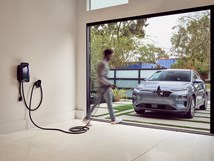Toyota, Partners Ready Real-Time HD Map Updates
Proof-of-concepts demonstrate faster, less expensive mapping techniques
Fully autonomous vehicles need to know precisely where they are at all times relative to the road and surrounding environment. We're talking within a few inches, opposed to as much as 15 ft with current GPS technology.
Efforts are well underway to create high-definition maps of major markets around the world. But the process, which typically has used dedicated survey fleets equipped with pricey lidar sensors, is time-consuming—and the maps can quickly become outdated.
Real-Time Updates
Toyota is developing new techniques that promise to be faster and cheaper.
Working with industry partners, the carmaker’s Toyota Research Institute-Advanced Development (TRI-AD) arm has created several proof-of-concept systems that can pinpoint a vehicle’s location within 50 cm (20 inches).
Cameras and Satellites
TRI-AD’s partnership with Maxar Technologies and NTT Data uses commercial satellite imagery. The technology automatically extracts relevant map information by analyzing, removing and correcting for cars, shadows and other superfluous data.

Urban street-level object detection with Carmera system. (Image: TRI-AD)
The system is accurate to within 25 cm, according to the partners. To date, they have mapped Tokyo and six international cities.
Another partnership with Carmera has mapped Tokyo and two unnamed U.S. cities. Teaming consumer-grade dash cameras with Camera’s computer vision and processing technologies, the system achieved a relative accuracy of 40 cm, which TRI says is a significant improvement over conventional camera-based systems.
Shared Approach
Toyota also partnered with TomTom and HERE Technologies to demonstrate how data can be shared and updated across different mapping platforms.
In the concept, lane markings and other data collected from vehicle sensors via TRI-AD’s automated mapping platform are automatically converted and applied to update TomTom’s cloud-based HD map.

Automatic generation of lane-level HD map via HERE partnership. (Image: TRI-AD)
After converting data formats and applying correcting algorithms, HERE’s “self-healing” technology automatically created surface maps of urban roads. This includes lane-level information used for Level 3 automated driving, according to TRI-AD.
RELATED CONTENT
-
On Fuel Cells, Battery Enclosures, and Lucid Air
A skateboard for fuel cells, building a better battery enclosure, what ADAS does, a big engine for boats, the curious case of lean production, what drivers think, and why Lucid is remarkable
-
GM Develops a New Electrical Platform
GM engineers create a better electrical architecture that can handle the ever-increasing needs of vehicle systems
-
Choosing the Right Fasteners for Automotive
PennEngineering makes hundreds of different fasteners for the automotive industry with standard and custom products as well as automated assembly solutions. Discover how they’re used and how to select the right one. (Sponsored Content)








